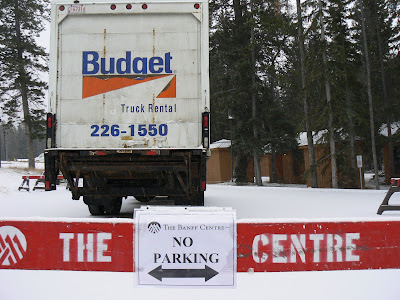 Put your foot on the gas!
Put your foot on the gas!I will be in White Rock, B.C., on January 20 and 21, 2008, for a bit of mid-winter post-turkey and truffles celebration of writing. It is going to be a special pleasure to bring my poem
Song for a Beached Whale at White Rock to town. She was beached there on the sand a few years back, and after she lay there, beached again, in my mind for a few years, she came out in this poem. A bit of the old testament, a lament for lost innocence, and a prayer for the voice, ah, I love this poem.
On Sunday, January 20, I will offer morning blue pencil sessions at the South Surrey/White Rock Community Arts Council Gallery. Editing doesn't have to be painful. Sometimes it's like this:

See, that's not so bad!
In the afternoon, I will present a writing workshop, that I call
Getting Unstuck Without Coming UndoneI mean, what with the fog one day and the stars that night, this is no time of the year for getting stuck in the back eddy of a plot. To get us all out of that, I've designed this workshop, to get us into the new year with style.
So, if writer’s block is peering at you from your breadbox, like this:
 July 1, 2007, Spences Bridge, B.C.
July 1, 2007, Spences Bridge, B.C.or if you have a character that has taken over and left your story behind, or if you can’t find the turning point to get your plot moving again, or have a poem that just won’t end, or can’t get an opening paragraph that will grab your publisher by the collar, or are writing a non-fiction piece that threatens to run away into fiction, well, nothing new there, is it. It's just any other day in a writer's world. I've been facing these ghouls down for 35 years, and have created a toolbox of techniques to get past them, and even to use their difficulties to drive my writing forward into new (well, I hope so!) directions.
So, bring a piece of your writing, or several pieces – or work on one of my many hand-outs, or on a piece you write in class. By the end of the day, I'll have passed along a good number of my own writing tools. By the time the day is over, you'll have a path to follow, and a good walking stick, too.
For more information or to register for the workshop or editing sessions, call 604-536-8333.
Hey, there's more!

I'll also be reading from my work at the Community Arts Council Gallery on Monday, January 21st. This event begins at 7 pm and is free of charge. Expect to hear my whale sing, selections from
Return to Open Water, my selected poems, and from
The Wolves at Evelyn, which won the 2007 George Ryga Award for Social Awareness in BC Literature.
 Thanksgiving Sunday, 2007, Penticton, B.C.
Thanksgiving Sunday, 2007, Penticton, B.C.I look forward to seeing you there.































